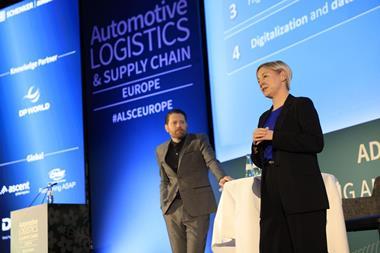 Many would characterise contracts between OEMs and vehicle logistics providers as being highly price focused and short term. But executives on both sides of the negotiating table are interested in agreeing terms that would encourage investment and deeper collaboration in the outbound supply chain.
Many would characterise contracts between OEMs and vehicle logistics providers as being highly price focused and short term. But executives on both sides of the negotiating table are interested in agreeing terms that would encourage investment and deeper collaboration in the outbound supply chain.
Many executives at finished vehicle logistics providers are prone to complain that contracted terms with carmakers tend to be too short, are overly focused on price, and don’t do enough to align the interests of providers with the customers that they serve, whether that would be improving empty backhauls or investing in new software equipment.
While such grumbles are likely an inevitable part of any customer-supplier relationship, the sheer frequency with which such complaints are heard tends to lend weight to the argument that there’s no smoke without fire. Logistics providers have probably got a point. At the recent ECG Conference, for example, logistics managers from OEMs in Europe including Honda, Hyundai-Kia and Opel/Vauxhall, admitted that their standard terms were two years. There were some exceptions, including the citing of occasional five-year deals, which tended to highlight the rule.
For some, the issue is fairly back and white. Robert Farrell, executive director of the American Trucking Association’s Automobile Carriers Conference (ACC), sums up the ideal length of a contract: “The longer the better.”
According to Farrell, most contracts in the US are for three years or less, even though loan terms on trucking equipment and vehicle depreciation periods are much longer. “The result is to expose the carrier to a period of uncertainty,” he says. “With longer contracts, there will always be more confidence in making such investments.”
Other insiders agree that the insistence on short-term deals and ever-tightening conditions on providers is probably not in the best interests of logistics providers or their automotive customers. Strict contract terms can often stifle capacity investment, as well as performance and innovations, according to Richard Gane, a 30‑year blue‑chip consulting firm veteran, ex‑automotive manufacturing engineer, and director of procurement consultants Vendigital.
“What we observe is that the logistics industry took out a lot of capacity when the downturn struck, and that capacity is still being built back up,” he says. “In the meantime, capacity is tight, automotive manufacturers are ducking and weaving on contractual terms and contract periods, and short-term contracts don’t really incentivise logistics providers to be flexible and responsive. So if, as a result, providers shrug their shoulders when asked for flexibility, and say: ‘We’ve met the contractual terms’, then you can’t really blame them.”
However, contractual terms are nuanced in their impact on the logistics business. Executives at other providers admit that longer contracts can prove restrictive and profit-sapping, preventing logistics providers and carmakers from taking advantage of changes in market conditions.
“When competition is fierce and ample capacity is available, then I would prefer to go for a short-term contract, as rates would probably have been driven down to the bare minimum,” concedes Bjorn Svenningsen, head of sales and marketing at European short-sea ro-ro operator UECC. “On the other hand, when spare capacity is low, and rates are at a relatively high level, then I would prefer to go for a longer-term contract duration.”
In that sense, much like investors locking themselves into fixed-interest bonds without knowing if rates will rise, a contract that is too long can be unpredictable and pose risks.
Onur Yalçin, manager of outbound logistics at Turkey’s Tofas, a Fiat joint venture, agrees that short-term contracts can be more favourable for momentary opportunities that arise in volatile working environments. “It shouldn’t be forgotten that these opportunities may arise for either [carmakers or LSPs],” he says.
However, despite the flexibility benefits of some short-term contracts, Yalçin thinks that strong relationships between OEMs and logistics providers would benefit further from long-term contracts. Most of Tofas’s main transport providers in Turkey have been working with the company for a long time, and the carmaker has seen benefits that resulted from a closer integration on both sides. Yalçin admits that everyone can benefit when the focus isn’t only on bidding for business.

“All in all, a healthy, longer-term contract will alleviate concerns and reflections created by the constant pressure of bidding, and [it will] foster investments and projects that pay off in the long term,” he says.
Short-term bonus can be a long-term malus
A dichotomy of views also occurs with the most obvious way of aligning the interests of providers and vehicle manufacturers: the inclusion of formal incentive-based payment mechanisms.
Yalçin says that Tofas has typically found performance-related pay arrangements to be instrumental in meeting lead-time goals for vehicle delivery. “Performance-related pay arrangements should serve to incentivise the reaching of desired service levels,” he says.
Furthermore, Tofas has also found gain-sharing agreements beneficial in other improvement proposals. For example, one of the company’s providers developed a solution for car carrying trucks that enabled Tofas to continue moving the same amount of vehicles even after Turkey tightened regulations on truck dimensions. “This solution not only eliminates extra costs that we would have felt from losses in capacity saturation, but it has also added to the competitiveness of the LSP,” says Yalçin.
Others are less sanguine. Kirk Williams, president and chief executive of US car transporter firm Proficient Auto Transport, doubts the efficacy of gain-sharing provisions in contracts. Having previously been responsible for transport at two of the largest 3PLs in the US, he’s seen gain-sharing contracts at close quarters.
“They work well in years one and two, but typically fail in subsequent years,” says Williams. “Once the gains are achieved and shared, the customer rightfully establishes a new benchmark from which to gain-share. Once peak performance has been established, it becomes increasingly difficult to improve further without radical changes to infrastructure, shipping patterns, and policy, almost all of which is outside the control of the carrier.”
That said, he concedes, there is nothing intrinsically wrong with contracts containing incentives, or indeed penalties: the danger comes when an element of incentive reward is seen by both parties as part of the normal return earned on a given contract.
 “I personally would be willing to belly up to the table and accept penalties for failing to meet the requirements, if those conditions had been clearly spelled out, and were agreed to up front”
“I personally would be willing to belly up to the table and accept penalties for failing to meet the requirements, if those conditions had been clearly spelled out, and were agreed to up front”
- Kirk Williams, Proficient Auto Transport
“I believe in performance-related pay arrangements if and when the carrier is starting with a rate that provides a competitive but healthy base-line margin,” he argues. “So if the carrier performs to the contract level, it continues to receive a fair price for meeting the requirements – and when it does better, then a reward or a share of the savings would be appreciated.
“And having said that, I personally would be willing to belly up to the table and accept penalties for failing to meet the requirements, if those conditions had been clearly spelled out, and were agreed to up front,” Williams adds.
Others also see the development of equitable performance-related pay arrangements as complicated. For one thing, risk is often disproportionately on the side of providers, according to Ray Fitzgerald, president for the Atlantic performance area (which includes the Americas, Europe, Africa, the Middle East and Russia) at shipping company and logistics providers Wallenius Wilhelmsen Logistics.
The starting point for some auto manufacturers is to place the vast majority of the risk on logistics service providers, while restricting or eliminating most of the incentives for upside gain,” he argues. “For performance‑related pay to work, agreements would need to be much more balanced, and also factor in flexibility for uncontrollable events, such as weather and the effect of third-party labour disruptions.”
Moreover, adds WWL’s Fitzgerald, many contract templates required by OEMs do not address other cost-reduction opportunities, such as the root causes for waste in the supply chain that lead to higher costs for all parties, he says. He points to delivery to ports for vessel sailings as an example.
“Capacity on a particular sailing is a perishable resource, and once a vessel sails, the cost of unused space is fixed and any revenue opportunity to offset it is lost,” he points out. “Too many auto manufacturers underperform in their ‘promise versus delivery’ on volumes booked. This drives cost and inefficiency for ocean operators, while greatly complicating business processes.

“That cost burden is placed on ocean carriers today, but in the future it needs to be transferred to the auto manufacturers, where the responsibility for performance in terms of delivery to the vessel resides,” Fitzgerald adds.
Don’t fixate on fixed terms
While there’s no magic bullet to solve these issues, industry executives routinely point to three separate changes that would, individually and collectively, represent a constructive step forward from today’s Mexican-style standoff.
The first involves a more widespread recognition that there are alternatives to the contractual model of fixed-price, fixed-term contracts, which are re-tendered on completion, and which do little to incentivise providers to invest or make improvements.
Subaru, as its executives recently told this magazine, uses rolling ‘evergreen’ contracts with logistics providers in the US. These last one year but are renewed automatically each year unless Subaru effects a change. Such contracts are a move in the right direction, say executives, but they’re still not enough.
“While year-to-year evergreen contracts are nice, they don’t provide the sense of security a longer-term agreement would provide,” notes Proficient’s Williams. “Much better would be five- or seven-year agreements, provided that were was a mechanism to account for inflation and any increased operating costs incurred by the carrier, such as tyres, lubricants, government-mandated safety and hours-of-service regulations, EPA [Environmental Protection Agency]-mandated engine guidelines, and the like.”
Today, he points out, most agreements have a fixed- or flat-rate schedule for the duration of the agreement with no inflation adjustments. Only some have a provision to review rates annually. “A long-term agreement gives the carrier the ability to provide a support infrastructure in terms of human capital as well as computer software and hardware,” says Williams. “And it helps if you know that, unless you underperform, you are going to keep a particular piece of business for a reasonable length of time, if not indefinitely.”
Matching flows to save
The second step suggested by industry insiders involves a move by both providers and OEMs to frame contracts – and their durations – around targeted collaborative opportunities.
Frank Schnelle, general manager for development and planning at Hyundai Group-owned logistics provider Hyundai Glovis, for instance, highlights instances in outbound vehicle shipping contracts where Glovis has seen ‘reverse flow’ opportunities suited to its own network.
“But we can’t exploit these opportunities because they’re not up for tender for another year or so. And of course, when they are up for tender, then we’re in the middle of another contract period ourselves,” he says. “The result is that there are matching vehicle flows in both directions, but an inability to seize the opportunity to reduce empty mileage.”
A better outcome, he suggests, would be one where carmakers routinely shared information on logistics flows, providing a platform for such matches to take place. With full, or at least fuller, loads in both directions, Schnelle argues, the resulting contracts would be difficult to beat on price. The contract duration would be framed in terms of the duration of the matching vehicle flows. In other words, when the match of logistics flows ended, so would the contract.
“We certainly have no strict company policy that would prohibit contracts being drawn up on this basis,” says Schnelle. “Nor do we think that others would. It’s a different way of doing things, but it doesn’t seem to be a big deal.”
 “[An LSP’s] added value is almost never confined within the boundaries of the OEM alone. In most cases the LSP assumes an intermediary role between the OEM and other sources of supply. “
“[An LSP’s] added value is almost never confined within the boundaries of the OEM alone. In most cases the LSP assumes an intermediary role between the OEM and other sources of supply. “
- Onur Yalçin, Tofas
Onur Yalçin agrees that there would be benefits in such an approach, including shared transport solutions and providers, better capacity utilisation and higher flexibility. Yalçin points out that, in most cases, logistics providers look across their OEM customers to find empty backhauls and make the most efficient use of resources. “Therefore the added value is almost never confined within the boundaries of the OEM alone,” he says. “In most cases the LSP assumes an intermediary role between the OEM and other sources of supply. This is another indirect added value.”
There are, nevertheless, practical questions over how OEMs might take the extra step of actualling coordinating tenders. Legal constraints on OEMs communicating together wouldn’t help to bring about such a situation, Schnelle concedes. A still bigger problem is that executives at carmakers aren’t especially warm to the idea.
“Our sense is that most auto manufacturers don’t want to share information on logistics flows – perhaps because they don’t see the need, or perhaps because they don’t see any logistics bottlenecks at the moment,” Schnelle observes. “If they don’t want to do it themselves, it’s possible that 4PLs might be able to undertake it for them, although it’s probably better if auto manufacturers did it, as they have the greatest visibility into their present and future requirements.”
Work with me, not against me
All of which leads to the third constructive step that carmakers and logistics service providers might be able to take by way of improving the contractual environment: eliminating or softening some of the attitudes underpinning procurement for logistics services.
“In some cases we have ‘partnership agreements’ with a manufacturer, focused on finding cost effective, sustainable solutions,” explains Fitzgerald. “They tend to be trust-based relationships, where the joint ambition is to seek out continuous improvement and deliver shared value. In these relationships, contractual terms and conditions provide a very basic framework for how both sides are to work.”
In other cases, admits Fitzgerald, arrangements are more “transactional”, with a price-driven relationship. In these contracts, terms and conditions are the defining aspects of the working relationship. “Such arrangements tend to be less flexible, and potential outcomes can lean heavily towards ‘win-lose’ scenarios,” he says.

Fitzgerald has no doubt over which arrangement has the best outcome. “One approach focuses on transportation cost, while the other focuses on total cost improvement,” he says. “Based on the outcomes we’ve experienced with various manufacturers, the partnership approach is more comprehensive and ultimately far more successful in terms of saving cost and time; whereas the transactional approach, though impactful against the yardstick of an internal objective or a single modal goal, tends to be sub‑optimal from an enterprise-wide perspective, as it does not adequately address waste or inefficiency.”
Others put it more bluntly. ACC’s Farrell contrasts those OEMs who regard logistics services as a commodity versus those investing strategically in their carrier base.
“The quid pro quo is clear: those carriers in the partner camp are more likely to be focused on servicing customers better. There’s more of a tendency to go above and beyond the call of duty, and be flexible and go the extra mile,” he observes. “Meanwhile, if another manufacturer has driven a carrier down on price, then the carrier is going to deliver on its promises, and fulfil its contract, but then focus on serving those customers where the relationship is stronger.”
While Yalçin admits that OEMs are likely to pursue flexibility in contracts, he maintains that, whatever the terms and conditions stipulated, “the underlying pre-condition is a shared base of values between the OEM and LSP”.
To that end, Yalçin prefers to see contracts as opportunities for both companies to explore new areas together – “a living contract evolving in time as experience grows,” as he puts it. That could include pursuing opportunities for leaner processes not only in transport but also in management and control of related processes, such as damage control, insurance, document processing and client notifications.
Such approaches sound like good news for providers looking to expand and offer new services to OEMs. But doing so depends on an openness and willingness to think long term on the part of both carmakers and providers. A move away from fixed price contracts; coordinating more collaborative tenders; and taking a less adversarial approach to contracting are topics that companies seem interested in exploring further.
But such optimism in reforming working relations cannot be mistaken for the reality in many cases today. Some insiders suggest that the imbalance of power between OEMs and providers mean that a major change in pricing and contract terms is unlikely – or at least difficult in the face of corporations’ large legal and purchasing departments, whose financial interests often supersede the objectives even of the OEM logistics managers responsible for the business.
“The agreements between many large corporations and their smaller carrier partners are often very one-sided, with the legal departments of the auto manufacturers having drafted the contracts with little input from the group of people responsible for executing and honouring them,” says Proficient’s Williams. “All too often, too, the agreement is nothing more than a boiler plate contract with a directive from the legal department that this is it, no modifications or changes can be made, take it or leave it.”

























![Global[1]](https://d3n5uof8vony13.cloudfront.net/Pictures/web/a/d/s/global1_726550.svgz)










